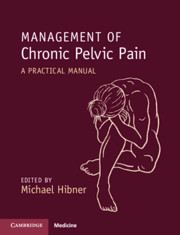Book contents
- Management of Chronic Pelvic Pain
- Management of Chronic Pelvic Pain
- Copyright page
- Contents
- Contributors
- Foreword
- Chapter 1 Introduction to Chronic Pelvic Pain
- Chapter 2 Neurobiological Basis of Pelvic Pain
- Chapter 3 History and Evaluation of Patients with Chronic Pelvic Pain
- Chapter 4 Psychological Assessment of a Female Patient with Chronic Pelvic Pain
- Chapter 5 Musculoskeletal Assessment for Patients with Pelvic Pain
- Chapter 6 Pharmacological Management of Patients with Pelvic Pain
- Chapter 7 Evidence for Surgery for Pelvic Pain
- Chapter 8 Pelvic Pain Arising from Endometriosis
- Chapter 9 Bladder Pain Syndrome
- Chapter 10 Pelvic Pain Arising from Pelvic Congestion Syndrome
- Chapter 11 Irritable Bowel Syndrome
- Chapter 12 Vulvodynia
- Chapter 13 Pelvic Pain Arising from Adhesive Disease
- Chapter 14 Pelvic Pain Arising from Ovarian Remnant Syndrome
- Chapter 15 Pudendal Neuralgia
- Chapter 16 Other Peripheral Pelvic Neuralgias
- Chapter 17 Chronic Pain After Gynecological Surgery
- Chapter 18 Pain Arising from Pelvic Mesh Implants
- Chapter 19 Treatment of Sexual Dysfunction Arising from Chronic Pelvic Pain
- Chapter 20 Physical Therapy Interventions for Musculoskeletal Impairments in Pelvic Pain
- Chapter 21 If Everything Else Fails
- Index
- References
Chapter 8 - Pelvic Pain Arising from Endometriosis
Published online by Cambridge University Press: 08 March 2021
- Management of Chronic Pelvic Pain
- Management of Chronic Pelvic Pain
- Copyright page
- Contents
- Contributors
- Foreword
- Chapter 1 Introduction to Chronic Pelvic Pain
- Chapter 2 Neurobiological Basis of Pelvic Pain
- Chapter 3 History and Evaluation of Patients with Chronic Pelvic Pain
- Chapter 4 Psychological Assessment of a Female Patient with Chronic Pelvic Pain
- Chapter 5 Musculoskeletal Assessment for Patients with Pelvic Pain
- Chapter 6 Pharmacological Management of Patients with Pelvic Pain
- Chapter 7 Evidence for Surgery for Pelvic Pain
- Chapter 8 Pelvic Pain Arising from Endometriosis
- Chapter 9 Bladder Pain Syndrome
- Chapter 10 Pelvic Pain Arising from Pelvic Congestion Syndrome
- Chapter 11 Irritable Bowel Syndrome
- Chapter 12 Vulvodynia
- Chapter 13 Pelvic Pain Arising from Adhesive Disease
- Chapter 14 Pelvic Pain Arising from Ovarian Remnant Syndrome
- Chapter 15 Pudendal Neuralgia
- Chapter 16 Other Peripheral Pelvic Neuralgias
- Chapter 17 Chronic Pain After Gynecological Surgery
- Chapter 18 Pain Arising from Pelvic Mesh Implants
- Chapter 19 Treatment of Sexual Dysfunction Arising from Chronic Pelvic Pain
- Chapter 20 Physical Therapy Interventions for Musculoskeletal Impairments in Pelvic Pain
- Chapter 21 If Everything Else Fails
- Index
- References
Summary
Endometriosis is the most common gynecological condition leading to pelvic pain and often it is the only one recognized by gynecologists. In many cases it coexists with pelvic floor muscle spasm, interstitial cystitis/bladder pain syndrome and irritable bowel syndrome and often all four are called “evil quadruplets.” Endometriosis can be diagnosed only surgically, and pathology confirmed tissue biopsy is by far the most accurate way of diagnosis. Unfortunately, all medical treatments of endometriosis are quite inadequate because they all rely on causing a hypoestrogenic state that only provides temporary relief of pain, and soon after medication is discontinued, symptoms return. Development of drugs addressing the cause of the disease is currently not possible because the cause of the disease is known. Multiple existing theories fail to explain all the cases, leading to the possibility that different etiologies may lead to a presence of endometrial glands and stroma in the peritoneal cavity and outside. Surgical resection of endometriosis in skilled hands is effective but patients need to be warned that disease will most likely return within a few years of initial surgery. Deep infiltrating endometriosis requires a very knowledgeable surgeon and often specialized center for treatment. Additional procedures such as presacral neurectomy, although controversial and potentially risky, may alleviate dysmenorrhea symptoms in some patients. Meticulous removal of ovarian endometriomas is a must in all infertility patients and most pelvic pain patients as simple drainage will result in almost immediate return of endometrioma.
- Type
- Chapter
- Information
- Management of Chronic Pelvic PainA Practical Manual, pp. 85 - 97Publisher: Cambridge University PressPrint publication year: 2021

